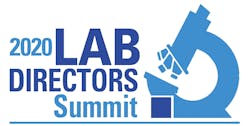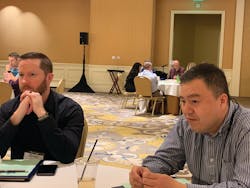Top industry takeaways revealed at the MLO Lab Directors Summit
The Lab Director Summit (LDS) program provided the attendees the opportunity to network and engage with senior-level decision-makers from healthcare labs that typically serve hospitals with 100 beds or more. The Summit is a unique way for attendees to learn from professionals who are in the in similar positions at their own facilities.
At the inaugural event, MLO was proud to host a wide range of Lab Directors and Pathologists from all walks of life from the most prestigious healthcare facilities to rural-location attendees, who were just as dedicated to the efficacy of their laboratory service and the test results they provide.
Before the Summit, MLO asked Laboratory Directors to tell us about their major concerns regarding operations, staffing, new technology adoption and visibility that affect their efficacy in delivering quality laboratory results. Based on this information, we created in-depth questions on topics and concerns that were mentioned most frequently by the attendees.
The meeting venue and schedule was designed to optimize the interaction between the attendees, as well vendor sponsors who had the chance to share meals and conversations with most of the attendees, if not all. The attendees had the opportunity to network at numerous roundtable discussions that MLO prepared, as well as meet with solution providers in the industry at Small Group Presentations, One-to-One meetings and multiple networking events.
The biggest difference between our meeting and any other is the ability and time for networking, which resulted in problem solving and information sharing between peers.
Top topics among attendees are listed below:
Strategies for recruiting and retaining quality staff
Are you having difficulty attracting and keeping highly qualified laboratory staff? What do lab professionals want and need to feel satisfied? If this is a pain-point for you, consider some small steps you could take right now to improve retention, as well as ideas that might need to be further developed into a formal policy requiring C-suite buy-in.
What are your solutions?
- Create Clinical Career Ladders at your facility. For example, cross-train phlebotomists to become lab assistants in MLS/MLT.
- Work with HR to offer sign-on bonuses, merit allowances and retention bonuses – Talk to HR about this step – most hospitals have this for other departments.
- Partner with local educational programs for Clinical Laboratory Scientists (CLS) Medical Laboratory Scientists (MLS) program–and offer internships at your lab with local nursing and science programs. You can also create a shadow program w/high schools and junior colleges in order to help build interest in the importance of the lab.
- Social media – Tweet out what your lab is doing in the community.
- Recruiters – Get rid of them. They don’t tell applicants the right story about the job expectations nor do they screen potential employees properly. Get applications emailed to you directly so you can do the screening.
- Succession planning – Pick top performers in your laboratory and elevate their role to oversee certain processes and/or quality control. It will give them the opportunity to experience leadership Key Performance Indications (KPIs), and you can measure their successes.
- Offer perks such as free parking/public transportation/day care/on-site gym, etc.
- Employee recognition program – include passports to “events”, PTO and/or education (aka association meetings).
- Have daily huddles and include peer recognition.
Are your reimbursements covering your costs?
What are your top concerns?
- How to survive outreach stresses–are immediate costs vs reimbursements not available as you build programs?
- Is Reference Lab usage delivering any cost savings?
- Is Administration Repository Directory (aka Supply Chain) asking for impossible reductions from vendors?
- Nursing homes and reimbursement issues on data capture and tests performed.
What are your solutions?
- Change staffing to 12-hour shifts
- Education of staff members to standardize processes
- Molecular testing as an effective increase for revenues
- Waste and efficiency studies to decrease overhead expenses
- Potential savings: review supply usage (i.e. tubes, butterflies)
- Health screen testing –bring testing in-house, use internal resources to save money
- Use analyzers that provide walkaway testing to reduce staffing in FTE hours.
- Reduce coding frustrations and modifications
Inventory control and consumable usage
What are your solutions?
- Track supply utilization and keep records. Review reports on supplies ordered as compared to the number of invoiced tests.
- Utilization as not really lab issue but an organization issue. CMO helps to be able to educate peers on Lab Stewardship.
- Partner with Materials Management and get access to their electronic inventory tracking.
- Push for a 30-day inventory instead of 60-90 days – especially for consumables with expiration dates. This will also save time on rotating excess inventory.
- Consider vendor links or vendor-managed ordering. The data could potentially come from the analyzer or remote connect to the vendor.
- Contract agreements – lease without volume commitments
- Service contract – It is not preferred to outsource service contracts to a third party. Try to use in-house biomed for technical equipment.
Improving quality, efficiency and test utilization
Test volume information can be leveraged to kick-start a lab test utilization program to further cut costs by reducing or eliminating unnecessary testing, while ensuring that clinically relevant testing is performed. Key aspects of such a program tied to cost reduction include standardizing test ordering practices and formularies, eliminating obsolete tests from formularies, monitoring for duplicate test orders and leveraging reflex testing capabilities to run tests only when indicated.
What are your top concerns?
- What can you do about physicians that order a test that have to be processed as send-outs?
- Implement a program that specifies pre-approvals on miscellaneous send-outs.
- Track send-outs that result after discharge.
- There are software tools that measure costly send-outs and the percentage of normalcy results and share the results with physicians.
- Inform staff on test monitoring and cost analysis–(example for IP patient email chain includes pathologist, MRO and Lab Director to determine if needed).
- How do you notify physicians that testing is a send-out?
- One solution is to add it to the check out list of tests when they fill out the orders.
- Would like to create a group to be interested in peer comparisons with like hospital labs.
- Some institutions have limitations on the number of tests ordered over a given time.
- Get evidence-based test utilization backed by data.
(one source mentioned was Eugenio Zabaleta PHD- great resource for test utilization and how you get physicians to order correctly.)
- Quality Reference - use the 12 QSE’s from “The Quality System Essentials (QSEs)”, from CLSI. https://clsi.org/standards/products/quality-management-systems/companion/lqms
- Organization
- Process Management
- Customer Focus
- Document and Records
- Facilities and Safety
- Information Management
- Personnel
- Nonconforming Event Management
- Purchasing and Inventory
- Assessments
- Equipment
- Continual Improvement
- Also implement an operating structure known in manufacturing as a “quality management system” (QMS) to ensure the quality testing and services.
Equipment evaluation: How to prioritize needs and capital
Capital justification is a major process for you as a laboratory administrator. You must be able to decide the capital needs of your laboratory, and then be able to convince the financial department and others in the institution that your need is not only justifiable, but also more important than other requests for capital made by other department administrators.
Examples include:
- New technology needed to remain competitive.
- Save staff hours/cover shortages with automated equipment.
- Replacement equipment (broken or too expensive to repair).
- AHA Guidelines are a good source for determining life of equipment/instruments.
- Leasing of equipment needs to be budget neutral.
- Physicians determine need of new equipment based on their specialties.
- Work with supply chain connections to create RFPs.
Use of automation to develop the lab of the future
Clinical lab directors should expect the medical device industry to look at laboratory automation through a new paradigm and consider where the laboratory professional’s workflow can be served by innovative ideas and approaches. Diagnostic laboratories have become such an integral part of the connected healthcare paradigm that methods for expanding their scalability, improving performance and managing data are critical to achieving the core objectives of meeting the needs of clinicians and patients. Improved efficiency and specimen traceability are achieved with automation.
Challenges – Develop best practices for adoption
- Designate a project manager who will coordinate with the vendor on immediate and long-term planning.
- Bring in or develop technical expertise.
- Develop a workflow/diagram/visual instrument placement in your facility.
- In space planning, analyze workflow processes and mapping – get IT involved early.
Create a future ready lab:
- Mobile remote testing
- Less staff/more technology equipment
- Less regulation
- Staff skill mix–licensed vs unlicensed
- Use of Artificial Intelligence (AI) in pathology
- Reimbursement
Bringing molecular and genetic testing to your lab
Many labs send test orders out for molecular testing if they don’t have the MDx analyzers in-house. The decision to bring molecular tests into your lab should be based on the anticipated volume of tests, the skill level of personnel, the anticipated cost of performing the test in-house vs outsourcing and the need for your facility to remain competitive in your region. The wealth of information from genetic and molecular testing provides a means to more effectively administer drugs and treatments and provides enhanced patient efficacy in treatments.
- Adoption of Molecular testing (MDx):
- Consider how it will be used–will it be the right fit?
- Consider who will run it–do they need training, what is their level of expertise?
- Cost–should it be laboratory developed test (LDT)?
- Is the right test being ordered for MDx use? What is the test utilization projected to be?
- Can we treat the result? Why would we need to know?
- Who has rights to the data to prevent it from being misused?
- Why is it important to have a molecular specialist on staff for test interpretation?
IT tools for clinical diagnostics
LIS/LIMS systems have grown from simple programs that handle the mechanics of laboratory billing to complete, end-to-end platforms that govern the entire business process and workflow of the laboratory. These IT systems are critical to the operation of a laboratory and must work in concert with instruments and automation for a laboratory to be successful. Decision support for these system choices can be found with vendors and associations.
What sources are needed to evaluate systems for your lab?
LIS evaluations can be found through the Association for Pathology Informatics. This organization’s LIS Functionality Assessment Toolkit provides methodology for assessing the functionality of, and enabling comparisons among, competing LIS systems. The toolkit provides information about how to search for a new LIS among the systems available in the market, how to develop a request for proposal (RFP), which is commonly used to manage system selection, and how to plan live vendor demonstrations. You can access this resource at https://www.pathologyinformatics.org/lis_toolkit.php.
- Evaluate what tools are needed–auto-validation, middleware, outreach, etc.
- The biggest need is for data analytics and data mining from your LIS/LIMS.
- What are your corporate IT limitations? Establish a bridge from your lab staff to corporate IT, to evaluate needs at the corporate level and how to collaborate on goals.
New technology adoption and effective training practices
Your lab has installed new software which you hope will improve the quality and efficiency of its work. You want to get your staff up to speed as soon as possible so everyone can effectively use and benefit from the software without delay. But you find that your staff’s learning curve is considerable. Training staff to use new software has inherent challenges.
How can training be made painless, quick, and successful?
- If the software is meant to be used by the majority of the lab’s staff, then a mid- to large-sized laboratory could have dozens or even hundreds of trainees. These challenges can be met, however, with “train-the-trainer” sessions. In this approach, the software vendor trains a select group of “super-users,” first.
- Have the IT department provide mandatory training for NEO (new employee orientation).
- Develop a lean process to create standard work and train staff.
- Create standard workflows with all stakeholders.
- Create “lunch and learn” training sessions.
- Follow up with vendor post-implementation.
- Send a lab person to LIS school.
Using metrics and Key Performance Indicators to drive successful outcomes
Describe the tools and other resources such as KPIs you use to gather metrics, measure performances and make effective decisions. What do your metrics reveal specifically - patient scheduling, patient care variations, test reruns, sample contamination rates, supply levels, compliance with regulations, etc.? How has the information helped you to improve lab efficiency and patient experience? What metrics would you like to be measuring better or differently? Have you gathered any data that you’re not sure how to act upon?
Suggested solutions:
- Daily visual management board – staff with ideas for cost-savings process improvement.
- Review your list of Key Performance Indicators (KPIs) and ensure they are being met or revise them to cover pain points. Use them to measure performance and accountability.
- Senior leader makes weekly rounds and reports to their supervisor.
- Conduct daily safety huddles in hospital labs.
- Do we need tools for data management?
- Do we measure too much but do nothing about it?
- Prioritize data – Red: Requires actions, Yellow: Caution, Green: Move threshold/discontinue analysis (complete).
- Are we measuring the right things that impact patient care, safety, costs?
- Engage key stakeholders outside lab to make changes.
- Value moving and process education
- Create a culture that is inspection-proof using checklists and links to your policies and documentation; Set up a policy review and tracking system.
Effective strategies and tactics for reducing costs
Cost-containment efforts are a universal undertaking in healthcare systems everywhere, and efforts to reduce costs can be made in dozens of areas using a variety of best practices and technology. Where is spending highest in your Lab? Can you pinpoint what’s causing it? What do you think is needed–and where is it needed–to curb unnecessary spending?
It’s all about reviewing:
- Review reference labs costs and contracts; Develop a good relationship with reps.
- Repatriate for lab tests
- Instrument standardization
- Multi-year contracts: Instead of 1-3, go for 7 years and include service metrics, as well as a technology update clause.
- Individualized Quality Control Plan (IQCP) your instruments to reduce QC variations.
- Calculate savings on everything. For example, autoverification of lab tests can save $.14 each x volume of tests – it adds up quickly.
- Staff engagement – post their name and the amount saved due to their suggestion.
- Review contracts with vendors with mutual products/positions.
- Review savings opportunity utilization on schedules.
- Review any big volume changes within 30 days up or down.
- Leverage your labs abilities with neighboring hospital labs – turnaround time (TAT) , etc.
- Reduce blood culture contamination and other wastes.
In summary…
There were many more questions and discussions that covered outreach, safety and cleaning, as well as more molecular testing adoption concerns, just to name a few. The sponsors were happy with the quality of the interaction and in particular with their ability to have One-to-One meetings. One well-known vendor used their small group presentation lab participants as an evaluation team for their current products and practices. Our Second Annual Lab Directors Summit will be in October 2020.
Feel free to contact me for more information - [email protected].




